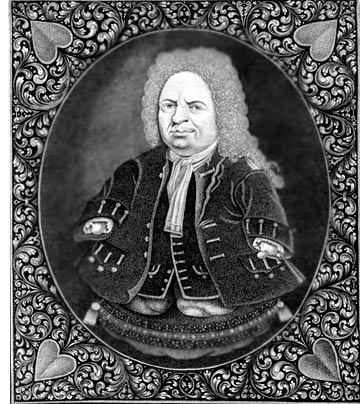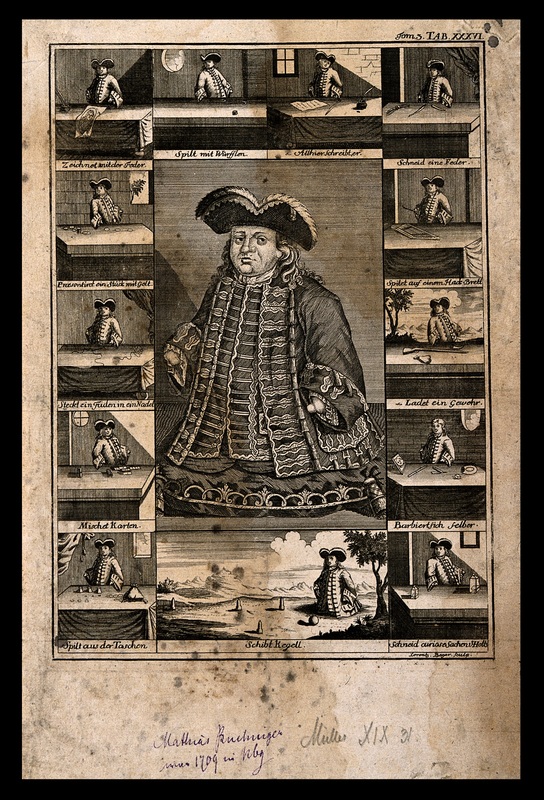This month we feature German artist, magician and illustrator, Matthias Buchinger.
An artist and performer, he demonstrated his accomplishments at many courts and became known as the "Little Man from Nuremberg." He traveled to England trying to get a court appointment with King George I; unsuccessful, he then moved to Ireland where he gave public demonstrations, in Dublin in 1720 and in Belfast in 1722.
Buchinger was also an accomplished magician, causing balls to disappear from under cups and birds to appear from nowhere. It was also said that he was unbeatable at cards and would dazzle audiences with his amazing displays of marksmanship.
In addition to conjuring, Buchinger enjoyed a great reputation as an engraver and an artist. Despite his having small, finlike appendages for hands, Buchinger had tremendous dexterity, liked to build ships in a bottle and his engravings were incredibly detailed. One such engraving, a self-portrait, was so detailed that a close examination of the curls of his hair revealed that they were in fact seven biblical psalms and the Lord's Prayer, inscribed in miniature letters. Also an accomplished musician, Buchinger's musical skills included the ability to play a half-dozen instruments including the dulcimer, hautboy, trumpet, and flute, some of which he invented himself.
Buchinger was married four times and had at least 14 children (by eight women). He is also rumored to have had children by up to 70 mistresses. Buchinger's fame was so widespread that in the 1780's the term "Buckinger's boot" existed in England as a euphemism for the vagina- because the only "limb" he had was his penis.
Buchinger died in Cork, Ireland at the age of sixty-six.
January 8–April 11, 2016
Exhibition Location: The Robert Wood Johnson, Jr. Gallery, 2nd floor, Gallery 690
Approximately 15 drawings by the 18th-century German artist Matthias Buchinger (1674–1739), who was born without hands or feet, are presented in Wordplay: Matthias Buchinger’s Drawings from the Collection of Ricky Jay, at the Metropolitan Museum through April 11, 2016. Despite his physical limitations, Buchinger was celebrated in his own time as a draftsman and calligrapher as well as a magician and musician, and poetic broadsides were written in Europe and Britain about his many talents and achievements. Known as “the Little Man of Nuremberg” because he was only 29 inches tall, Buchinger lived a nomadic existence and boasted a clientele that included noblemen, kings, and emperors, along with members of the public who visited him at inns and fairs, from Leipzig to Paris and London to Belfast.
A remarkable Buchinger drawing of a trompe-l’oeil calendar from the Metropolitan Museum’s collection is displayed alongside drawings, prints, and related ephemera from the collection of Ricky Jay, the celebrated illusionist, actor, and author. Framing Buchinger’s stupendous works, which were composed largely through calligraphy and micrography (a traditionally Jewish art form dating to the 9th century in which minute lines of text are used to shape patterns or forms), are works from the Metropolitan Museum’s collection that place Buchinger in the context of works on paper from the late Middle Ages to the present day. These additional works include decorated alphabets from Renaissance to contemporary prints, 17th-century instruction books for writing and calligraphy, medieval manuscripts, and works by modern and contemporary artists for whom language is a fertile field for exploration.
Exhibition Credits and Related Programs
Wordplay: Matthias Buchinger’s Drawings from the Collection of Ricky Jay is organized by Freyda Spira, Associate Curator, with Femke Speelberg and Jennifer Farrell, also Associate Curators, of the Metropolitan Museum’s Department of Drawings and Prints.
New York Times architecture critic Michael Kimmelman and Ricky Jay will discuss Matthias Buchinger in a “MetSpeaks” ticketed talk that will take place in the Grace Rainey Rogers Auditorium on January 21, 2016.
Matthias Buchinger: “The Greatest German Living” written by Ricky Jay is published by Siglio and is available in the Museum’s book shop ($39.95).
Additional information about the exhibition and its accompanying programs are available on the Museum’s website, metmuseum.org, as well as on Instagram and Twitter using #MatthiasBuchinger.
Wordplay is part of the centennial celebration in 2016 of The Metropolitan Museum of Art’s Department of Prints. The department’s astounding collection of prints now numbers over a million works that represent the full scope of printmaking in Europe and the Americas from approximately 1400 to 2015, ranging from the earliest known European woodcuts of the 15th century to Rembrandt and Goya’s experimental etchings, Pablo Picasso’s linocuts, Mexican broadsides, and Kara Walker’s offset lithographs. Brilliantly mixing the exceptional with the everyday, the Museum’s collection is the most comprehensive in the United States and rivals the eminent and much older collections at the British Museum, London, the Bibliothèque Nationale de France, Paris, and the Albertina in Vienna. #MetOnPaper100


 RSS Feed
RSS Feed